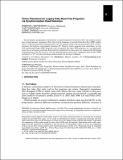Files in this item
Fence placement for legacy Data-Race-Free programs via synchronization read detection
Item metadata
| dc.contributor.author | McPherson, Andrew J | |
| dc.contributor.author | Nagarajan, Vijay | |
| dc.contributor.author | Sarkar, Susmit | |
| dc.contributor.author | Cintra, Marcelo | |
| dc.date.accessioned | 2016-03-09T12:40:03Z | |
| dc.date.available | 2016-03-09T12:40:03Z | |
| dc.date.issued | 2016-01-07 | |
| dc.identifier | 175329206 | |
| dc.identifier | a056d73c-8f21-49cd-a332-657620f5cff2 | |
| dc.identifier | 84954223670 | |
| dc.identifier | 000367950500014 | |
| dc.identifier.citation | McPherson , A J , Nagarajan , V , Sarkar , S & Cintra , M 2016 , ' Fence placement for legacy Data-Race-Free programs via synchronization read detection ' , ACM Transactions on Architecture and Code Optimization (TACO) , vol. 12 , no. 4 , 46 . https://doi.org/10.1145/2835179 | en |
| dc.identifier.issn | 1544-3566 | |
| dc.identifier.other | ORCID: /0000-0002-4259-9213/work/125727572 | |
| dc.identifier.uri | https://hdl.handle.net/10023/8387 | |
| dc.description | We thank the anonymous reviewers for their helpful comments for improving this article. This research is supported by EPSRC grant EP/L000725/1 and an Intel early career faculty award to the University of Edinburgh. | en |
| dc.description.abstract | Shared-memory programmers traditionally assumed Sequential Consistency (SC), but modern systems have relaxed memory consistency. Here, the trend in languages is towards Data-Race-Free (DRF) models, where, assuming annotated synchronizations and the program being well-synchronized by those synchronizations, the hardware and compiler guarantee SC. However, legacy programs lack annotations, so even well-synchronized (legacy DRF) programs aren’t recognized. For legacy DRF programs, we can significantly prune the set of memory orderings determined by automated fence placement, by automatically identifying synchronization reads. We prove our rules for identifying them conservative, implement them within LLVM, and observe a 30% average performance improvement over previous techniques. | |
| dc.format.extent | 23 | |
| dc.format.extent | 311499 | |
| dc.language.iso | eng | |
| dc.relation.ispartof | ACM Transactions on Architecture and Code Optimization (TACO) | en |
| dc.subject | Fence placement | en |
| dc.subject | Relaxed memory models | en |
| dc.subject | QA75 Electronic computers. Computer science | en |
| dc.subject | NDAS | en |
| dc.subject | MCP | en |
| dc.subject.lcc | QA75 | en |
| dc.title | Fence placement for legacy Data-Race-Free programs via synchronization read detection | en |
| dc.type | Journal article | en |
| dc.contributor.institution | University of St Andrews. School of Computer Science | en |
| dc.identifier.doi | 10.1145/2835179 | |
| dc.description.status | Peer reviewed | en |
This item appears in the following Collection(s)
Items in the St Andrews Research Repository are protected by copyright, with all rights reserved, unless otherwise indicated.

